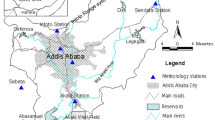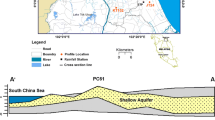Abstract
Estimated groundwater recharge for selected locations in northeast Peninsular Malaysia (North Kelantan River catchment) was determined using the water table fluctuation (WTF) and chloride mass balance (CMB) methods. The WTF method recharge estimates were compared to the CMB method estimates to see if results are similar and the methods can be applied in a humid, tropical region, such as Malaysia. Effective specific yields of 0.18 and 0.16 were obtained for sites which are much lower than values in the literature for use with the WTF method. The WTF gives mean recharge values of 447 and 319 mm/year at PC61 and Wakaf Bharu (WB), respectively. The difference between sites may be attributed to the difference in lithology, whereby less water table fluctuation is observed for finer-grained lower permeability soil or sediment and higher water table fluctuation observed for more granular larger grain soil or sediment. For the site with lower permeability, the time lag between the storm events and water level rise in a well is longer and water does not reach the water table for small storms. Recharge from chloride profile study was estimated through measurement of enrichment of chloride concentration in soil. Rain-fed groundwater direct recharge ranged from 263.3 to 627.7 mm/year in WB and averaged 691.8 mm/year for Pengkalan Chepa. Recharge estimates from unsaturated zone chloride strongly correlate with soil texture, generally and is greater in the coastal area due to a higher percentage of sand content. Parts of the study area located toward the interior of the peninsula showed lower recharge due to the presence of fine-grained sediment. Comparison of methods from different sites indicates that lithologic setting has a significant role in controlling natural recharge rate. The inconsistency observed between recharge value estimated by the WTF and CMB method may in part be due to adsorption/desorption process and ion exchange in the unsaturated soil, which affects the initial assumption that chloride is a conservative tracer.








Similar content being viewed by others
References
Allison GB, Hughes MW (1978) The use of environmental chloride and tritium to estimate total recharge to an unconfined aquifer. Aust J Soil Res 16:181–195
Allison GB, Stone WJ, Hughes MW (1985) Recharge in karst and dune elements of a semi-arid landscape as indicated by natural isotopes and chloride. J Hydrol 76:1–26
Andre F, Jonard M, Ponette Q (2007) Influence of meteorological factors and polluting environment on rainfall chemistry and wet deposition in a rural area near Chimay, Belgium. Atmos Environ 41:1426–1439
American Society of Testing Materials (1977) Adsorption and bulk specific gravity of natural building stone: American Society of Testing Materials, ANSVASTM R97-47, Annual Book of ASTM Standards, Part 19, p 472
Bierkens M, Knotters M, Hoogland T (2001) Space-time modeling of water table depth using a regionalized time series model and the Kalman filter. Water Resour Res, 375. doi:10.1029/2000WR900353
Bromley J, Edmunds WM, Fellman E, Brouwer J, Gaze SR, Sudlow J, Taupin JD (1997) Estimation of rainfall inputs and direct recharge to the deep unsaturated zone of southern Niger using the chloride profile method. J Hydrol 188:139–154
Chong FS, Pfeiffer D (1975) Hydrogeological map of Peninsular Malaysia Peta hidrogeologi semenanjung Malaysia. Director General of Geological Survey, Malaysia
Chong FS, Tan DNK (1986) Hydrogeological activities in Peninsular Malaysia and Sarawak. GEOSEA V Proceedings, Vol. II. Geological Society Malaysia, Bulletin 20, August 827–842
Chong FS, Pfeiffer D, Tiedemann O (1977) German hydrogeological mission in Malaysia. Hydrological report (GPH.11/1977). Ipoh Perak, Malaysia
Cook PG, Edmunds WM, Gaye CB (1992) Estimating paleorecharge and paleoclimate from unsaturated zone profiles. Water Resour Res 28(10):2721–2731
Cook PG, Scanlon BR, Goldsmith RS (1997) Field study of spatial variability in unsaturated flow beneath and adjacent to playas. Water Resour Res 33(10):2239–2252
Crosbie R, Binning P Kalma J (2005) A time series approach to inferring groundwater recharge using the water table fluctuation method. Water Resour Res. doi:10.1029/2004WR003077
Edmunds WM, Darling WG, Kinniburgh DG (1988) Solute profile techniques for recharge estimation in semi-arid and arid terrain. In: Simmers I (ed) Estimation of natural groundwater recharge. Dordrecht Reidel, pp 139–157
Edmunds WM, Gaye CB (1994) Estimating the spatial variability of groundwater recharge in the Sahel using chloride. J Hydrol 156:47–59
Edmunds WM, Fellman E, Goni IB, Prudhomme C (2002) Spatial and temporal distribution of groundwater recharge in northern Nigeria. Hydrogeol J 10(1):205–215
Eriksson E, Khunakasem V (1969) Chloride concentrations in groundwater, recharge rate and rate of deposition of chloride in the Israel coastal plain. J Hydrol 7:178–197
Flint LE (1998) Characterization of hydrogeologic units using matrix properties, Yucca Mountain, Nevada. U.S.G.S. 97-4243. Denver, Colorado
Gaye CB, Edmunds WM (1996) Groundwater recharge estimation using chloride, stable isotopes and tritium profiles in the sands of northwestern Senegal. Environ Geol 27:246–251
Graham W, Tankersley C (1993) Forecasting piezometric head levels in the Floridan aquifier: a Kalman filtering approach. Water Resour Res, 29(11). doi:10.1029/93WR01813
Guan H, Love A, Simmons CT, Ding Z, Hutson J (2009) Catchment conceptualisation for examining applicability of chloride mass balance method in an area of historical forest clearance. Hydrol Earth Syst Sci 6:7025–7053
Healy RW (2010) Estimating groundwater recharge. Cambridge University Press, Cambridge p 245. ISBN 978-0-521-86396-4
Healy RW, Cook PG (2002) Using ground-water levels to estimate recharge. Hydrogeol J. doi:10.1007/s10040-001-0178-0
Heliotus FD, DeWitt CB (1987) Rapid water table response to rainfall in a northern peatland ecosystem. Water Resour Bull 23(6):1011–1016
Hem JD (1989) Study and interpretation of the chemical characteristics of natural water; 3rd Edition. U.S. Geological Survey Water-Supply Paper 2254, Washington D.C., p 263
Hutchison CS, Tan DNK (2009) Geology of Peninsular Malaysia (Eds.). University of Malaya/Geological Society of Malaysia, Kuala Lumpur. p 479. ISBN: 978-983-44296-9
Isbell RF (2002) The Australian soil classification. CSIRO Publishing, Australia
Ismail CM (1993) Record of Groundwater monitoring Wells in the Kota Bharu Area, Kelantan. GPH 6/1993. p 96
Jackson PE (2000) Ion chromatography in environmental analysis. In encyclopedia of analytical chemistry. Wiley, Chichester, p 25
Jackson TJ (2006) United States Department of Agriculture-Agricultural Research Service (USDA-ARS), Beltsville, Maryland, U.S.A. Encyclopedia of Soil Science, Taylor & Francis. doi:10.1081/E-ESS-120042757
Johnson AI (1967) Specific yield—compilation of specific yields for various materials. U.S. Geological Survey Water Supply Paper 1662-D, p 74
Kamprath EJ, Nelson WL, Fitts JW (1956) The effect of pH, sulfate and phosphate concentrations on the adsorption of sulfate by soils. Soil Sci Soc Am J 20(4):463–466
Keywood MD, Chivas AR, Fifield LK, Cresswell RG, Ayers GP (1997) The accession of chloride to the western half of the Australian continent. Aust J Soil Res 35:1177–1189
Kresic N (2007) Hydrogeology and groundwater modeling. CRC Press, Boca Raton, p 807
Liu G, Wang Y, Zang Y, Song T (2009) Application of chloride profile and water balance methods in estimating groundwater recharge in Luanjing Irrigation Area, Inner Mongolia. Hydrol Sci J 54(5):961–973. doi:10.1623/hysj.54.5.961
MacDonald S (1967) The geology and mineral resources of North Kelantan and North Trengganu. Dichetak di-Jabatan Chetak Kerajaan. Volume 10 of Geological survey district memoir, p 202
Mayboom P (1967) Groundwater studies in the Assiniboine river drainage basin: part II, hydrologic characteristics of phreatophytic vegetation in south-central Saskatchewan. Geolog Surv Can Bull, vol 139
McWorter DB, Sunada DK (1977) Groundwater hydrology and hydraulics, Water Resources Publications. Ft. Collins CO
Mizwan A, Rashid Ab (2011) Laporan Pemantauan Air Tanah Kelantan 2005–2010 (JMG.KLT. 05/2011). Minerals and Geoscience Department Malaysia. p 35
Nimmo JR, Perkins KS (2008) Effect of soil disturbance on recharging fluxes: case study on the Snake River Plain, Idaho National Laboratory, USA. Hydrogeol J 16:829–844
NIST (1995) Environmental inorganic standard reference materials. National Institute of Standards and Technology, Philadelphia
Nolan BT, Healy RW, Taber PE (2007) Factors influencing ground-water recharge in the eastern United States. J Hydrol 332:187–205
O’Brien R, Keller CB, Smith JL (1996a) Multiple tracers of shallow ground water flow recharge in hilly loess. Groundwater 34:675–682
O’Brien R, Keller CB, Smith JL (1996b) Multiple tracers of shallow ground water flow recharge in hilly loess. Groundwater 34:675–682
Pfeiffer D, Tieddemann O (1986) Hydrogeological studies and the Ddevelopment of groundwater in the Kelantan Coastal Plain, Malaysia. Nat Resour Dev 24:72–82
Phillips FM (1994) Environmental tracers for water movement in desert soils of the American south-west. Soil Sci Soc Am J 58(1):15–24
Russo LO, Zavattaro SL, Acutis M, Zuppi GM (2003) Chloride profile technique to estimate water movement through unsaturated zone in a cropped area in subhumid climate (Po Valley, NW Italy). J Hydrol 270:65–74
Russo D, Zaidel J, Laufer A (2001) Numerical analysis of flow and transport in a combined heterogeneous vadose zone—groundwater system. Adv Water Resour 24:49–62
Scanlon BR (1991) Evaluation of moisture flux from chloride data in desert soils. J Hydrol 128:137–156
Scanlon BR, Healy RW, Cook PG (2002) Choosing appropriate techniques for quantifying groundwater recharge. Hydrogeol J 10:18–39
Sharma ML, Hughe MW (1985) Groundwater recharge estimation using chloride, deuterium and oxygen-18 profiles in the deep coastal sands of Western Australia. J Hydrol 81:93–109
Scanlon BR, Stonestrom DA, Reedy RC, Leaney FW, Gates J, Cresswell RG (2009) Inventories and mobilization of unsaturated zone sulfate, fluoride, and chloride related to land use change in semiarid regions, southwestern United States and Australia, Water Resour Res, 45, W00A18. doi:10.1029/2008WR006963.
Simmers I (1988) Estimation of natural groundwater recharge. D. Reidel Publishing Co, Boston, p 510
Sophocleous MA (1985) The role of specific yield in ground-water recharge estimations: a numerical study. Ground Water 23(1):52–58
Sophocleous MA (1991) Combining the soil water balance and water-level fluctuation methods to estimate natural groundwater recharge: practical aspects. J Hydrol 124:229–241
Takounjou AF, Ndam Ngoupayou JR, Riotte J, Takem GE, Mafany G, Maréchal JC, Ekodeck GE (2011) Estimation of groundwater recharge of shallow aquifer on humid environment in Yaounde, Cameroon using hybrid water-fluctuation and hydrochemistry methods. Earth Environ Sci Environ Earth Sci, 64(1):107–118. doi:10.1007/s12665-010-0822-x
Thurman EM (1985) Organic geochemistry of natural waters. Nijhoff/junk, Dordrecht
Ting CS, Liu CW, Tsai WW (1996) Design of a groundwater level monitoring network for the Pingtung Plain, Taiwan. In: Liu CW (ed) Proceedings 8th conference on hydraulic engineering, Taipei. National Taiwan University, Taiwan, pp 845–852
Ting C, Kerh T, Liao C (1998) Estimation of groundwater recharge using the chloride mass-balance method, Pingtung Plain, Taiwan. Hydrogeol J 6(2):282–292
Todd DK, Mays LW (2005) Groundwater hydrology. Wiley, New York
van Genuchten MT (1980) A closed-form equation for predicting the hydraulic conductivity of unsaturated soils. Soil Sci Soc Am J 44:892–898
Viswanathan MN (1984) Recharge characteristics of an unconfined aquifer from the rainfall-water table relationship. J Hydrol (Amst) 70(1–4):233–250
Walker GR, Jolley ID, Cook PG (1991) A new chloride leaching approach to the estimation of diffuse recharge following a change in land use. J Hydrol 128:49–67
Weeks EP (1979) Barometric fluctuation in wells tapping deep unconfined aquifers. Water Resour Res 15(5):1167–1176
Weeks EP (2002) The Lisse effect revisited. Ground Water 40(6):652–656
Acknowledgments
The authors are grateful to the University Malaya for facilities and funding provided through research grant reference PV112-2012A. In addition, it was not possible the carry out this research without the extensive help from Air Kelantan Sdn. Bhd.
Author information
Authors and Affiliations
Corresponding author
Rights and permissions
About this article
Cite this article
Saghravani, S.R., Yusoff, I., Wan Md Tahir, W.Z. et al. Comparison of water table fluctuation and chloride mass balance methods for recharge estimation in a tropical rainforest climate: a case study from Kelantan River catchment, Malaysia. Environ Earth Sci 73, 4419–4428 (2015). https://doi.org/10.1007/s12665-014-3727-2
Received:
Accepted:
Published:
Issue Date:
DOI: https://doi.org/10.1007/s12665-014-3727-2




